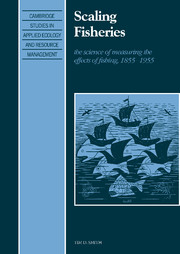Part III - THREE PARTIAL THEORIES, 1940–1955
Published online by Cambridge University Press: 22 September 2009
Summary
The methods of the study of fishery population dynamics that were developed by the early 1930s were applied in many fisheries around the world. Out of these applications came three particularly important theoretical developments that formed the basis for the management of fisheries after the Second World War. In Part III, I describe the development of these three theories, all of which are best described as partial theories. They focus on: (1) maximizing the total production each year, the surplus production theory; (2) maximizing the number of spawners returning from each year's spawning, the spawner and recruit theory, and (3) maximizing the yield obtained from whatever young fish appear each year, the yield per recruit theory.
In chapter 7, I describe an important fishery that began in California in the 1920s and increased rapidly through the 1930s, only to collapse in the 1940s, leaving behind the abandoned canneries immortalized in John Steinbeck's Cannery Row. This fishery demonstrates many important aspects of both fishing and the scientific study of fishing, and it amply illustrates Graham's Law of Fishing. There were large initial profits, profits that went to purchasing more fishing vessels and canning equipment. Very strong industrial interests developed, as did social concerns about too much fishing and the proper use of the fish caught. Scientific studies by the California Fish and Game Commission showed that the ever increasing levels of fishing could not be sustained.
- Type
- Chapter
- Information
- Scaling FisheriesThe Science of Measuring the Effects of Fishing, 1855–1955, pp. 237 - 238Publisher: Cambridge University PressPrint publication year: 1994



